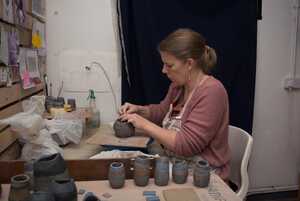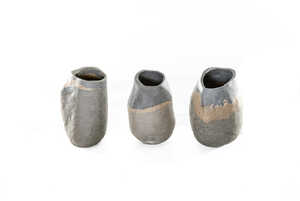From Clay to Form: Crafting Vessels Inspired by the South West Landscape
The Making Process
Each collection of my ceramic art vessels takes five weeks to complete, from colouring the clay to the final polishing. It’s a slow, meaningful process that reflects care, patience, and a deep respect for materials. I always work in sets, and between each stage, the pieces rest under plastic sheeting on boards to dry for a full week.


I begin by preparing three distinct colours of clay. Each colour is clearly labelled to avoid cross-contamination and to maintain the purity of tone. Once the clay is ready, I start forming the base. This method was inspired by Jennifer Lee, the renowned silent ceramist, who constructs her bases using plaster moulds. I shape my bases and leave them upside down to firm up before moving on to build the sides.


Once the bases have firmed up and are holding their shape, I select the design I’ll use for each vessel. I then begin rolling coils in the chosen base colour. The first coil is carefully joined to the pre-formed base by scoring and moistening the edge, ensuring a strong bond between the firmer base and the wetter coiled clay.
Building the sides is a creative and intuitive process. I work from five core designs that guide the pattern, colour, and form of each vessel. Each piece is hand-coiled and follows these guiding templates, yet no two are ever exactly alike. I let each vessel “speak” to me during its creation, allowing for subtle variations. Like Brancusi, the Romanian sculptor, I believe in honouring the nature of the material—letting its properties shape the final outcome.
This stage demands stillness and focus. Coils are added gradually, and the vessel is rotated often to check balance and symmetry. The work is physical, and the rhythm of coiling, pressing, and smoothing becomes meditative. It’s in this rhythm that the vessel begins to come to life—emerging slowly, layer by layer, from clay into form.



The final three stages are all about refinement: fettling and polishing. This part alone takes three weeks. First, I shape the vessel more precisely using a serrated kidney tool. After allowing it to rest under plastic, I refine the surface with metal tools. Once the clay reaches a leather-hard state, I sand it using progressively finer grades of wet and dry paper until the surface becomes smooth and polished—like a pebble found by the sea.
These five uniquely sized art vessels are deeply rooted in the colours, forms, and lines of the South West landscape. They are slow and methodical to make, and each piece is crafted with purpose and intention. I hope you enjoy the designs—and perhaps take one home to bring a piece of this quiet, thoughtful process into your own space.
Posted by Karen Dawn Curtis on July 10th 2025








